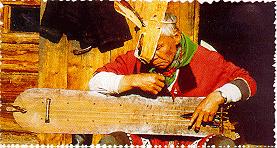
Finno-Ugric speaking peoples are, like Basques, ancient inhabitants in Europe. Before the Völkerwanderung mainly Finno-Ugric languages were spoken in Eastern Europe. The relation between Finno-Ugric languages was discovered at the end of 18th century by a Hungarian, János Sajnovics (1733-1785). An independent branch of linguistics has grown out of the Hungarian theologian's research - Finnougristics, which has broadened into Uralistics (study of the Uralic languages), also including the Samoyed languages. Sometimes while talking about Finno-Ugrians, we mean all the Uralic peoples, i.e. also Samoyeds. However, the common features of the Finno-Ugric (Uralic) peoples are not only the relatedness of their languages. In the traditional culture of the Finno-Ugric peoples there are similarities which exclude them from other peoples. Some of the Finno-Ugric cultural peculiarities have become of current interest recently. For instance, the surrounding nature, dead and alive is not taken as an object, but more as a dialogue partner. The structure of the Uralic languages has affected the thinking of people, which certainly influences the impact of socialising, and enriches the world culture. Not less important is the political aspect of the Finno-Ugric union. The gaining of cultural and political independence of Finland and Estonia has surely been influenced by becoming conscious of the relatedness to Hungarians. Nowadays, especially the Finno-Ugrians of Russia are stimulated by the thought that they are related to Finns, Hungarians and Estonians. Despite the language relation, Finno-Ugric peoples differ in race, religion and culture. Western Finno-Ugrians are Europides, but their eastern relatives, Khanties and Mansi, the closest relatives to Hungarians, have mixed with Mongoloids; Samoyeds are mostly Mongoloids. This shows that racism should be alien to the Finno-Ugrian movement. Culturally, the Baltic-Finns and Hungarians are typical European peoples. The culture of Volga-Finnic and Permian peoples is agrarian as they have not succeeded in creating their own urban culture because of many political and cultural reasons. Ob-Ugric and Samoyed peoples lead a life in their traditional societies with corresponding culture, which are most vulnerable. Concerning religion Estonians, Finns and western Sámi are Lutherans, Hungarians are mostly Catholics (though there are Calvinists and Lutherans). In the European part of Russia the main part of the Finno-Ugrian population is orthodox, among the Udmurts and Mari people animism can still be detected. Siberian Ugrians and Samoyeds are shamanists. Politically the Finno-Ugric peoples are of very different faith and status. Finland was autonomous already in the Russian Empire. It had its own parliament and currency. Estonians gained their independence only in 1918. Estonia was occupied and annexed by the Soviet Union in 1940. Together with Hungary, Estonia became a part of the communist block, Finland at the same time managed to maintain market economy and democratic state regulations. Sámi live on the territory of four states, and have only recently started to reestablish their unity. The Finno-Ugrians of Russia have their own (formerly called "autonomous") republics or autonomous regions, but in all these areas (except Komi-Permyak Autonomous Region) Finno-Ugrians are in minority. They do not have a single mother-tongue secondary school and not everywhere is it possible for them to attain primary education in their native languages. Although recent changes in Russia have made it possible for ethnic minorities to develop their identity and organisations have been founded to promote this process, the practical possibilities of the Finno-Ugric peoples to gain education in their mother tongue and to maintain their culture is in fact scant and varies between different peoples and different areas. Komi language, for example is, beside Russian recognised as an official language in Komi Republic, (which does not mean that you are welcome to speak Komi in all public institutions). In the republic of Mari El the president is required to speak Mari, but, for instance in the republic of Mordovia the Erzyans and Mokshas have very little hope to acknowledge a native school education. The diversity of Finno-Ugric (Uralic) peoples could also be their power: as we think the same way, it is easier for us to understand each other, and as we differ, we have something to discuss enriching each other's culture.